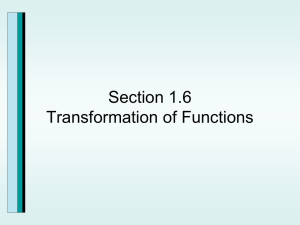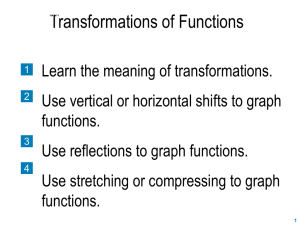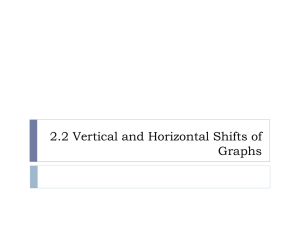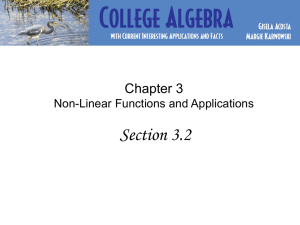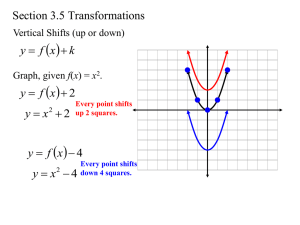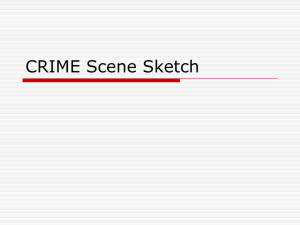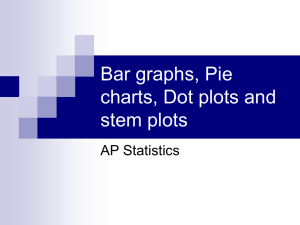Section 3.3
advertisement
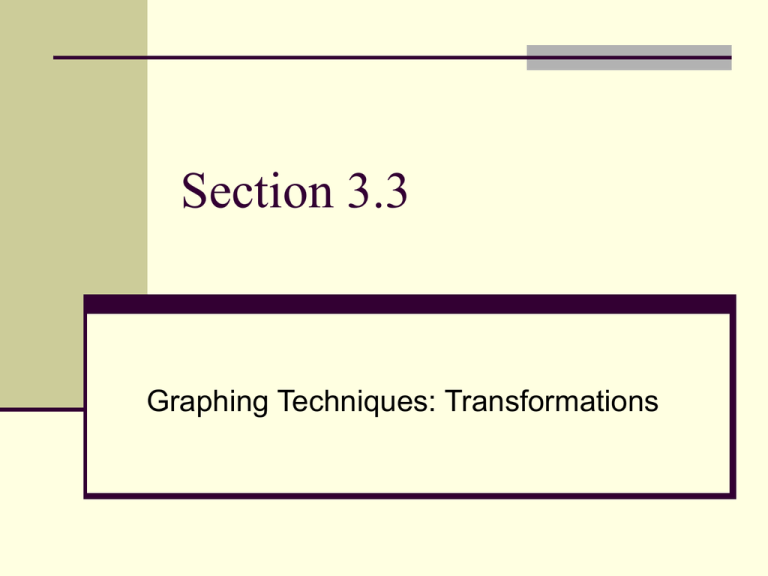
Section 3.3 Graphing Techniques: Transformations Horizontal and Vertical Shifts We investigated what the graph f ( x) x Let’s also graph g ( x) x 2 and h( x) x 1 x f(x) x g(x) x h(x) -2 2 -2 4 -2 3 -1 1 -1 3 -1 2 0 0 0 2 0 1 1 1 1 3 1 0 2 2 2 4 2 1 Horizontal and Vertical Shifts (cont.) We can notice that the graph of g(x) looks very similar to f(x) but moved on the coordinate plane. How did it shift? Up two spaces h(x) also looks similar to f(x) but shifted. How did it shift? Right one space f(x) is called the “Parent Function” Vertical Shift Given the graph of some parent function f(x)… To graph f(x) + c Shift c units upward To graph f(x) – c Shift c units downward Adding or subtracting a constant outside the parent function corresponds to a vertical shift that goes with the sign. Examples of “outside the function” x 2 x 4 3 Horizontal Shift Given the graph of some parent function f(x)… To graph f(x + c) Shift c units left To graph f(x – c) Shift c units right Adding or subtracting a constant inside the parent function corresponds to a horizontal shift that goes opposite the sign. Examples of “inside the function” x 3 2 x 1 x2 Explain how this graph shifts compared to its parent graph g ( x) x 2 Up 2 Right 3 h( x) x 2 3 Left 2 f ( x) x 3 j ( x) x 4 Down 4 Given the parent function f(x) = x2, write a new equation with the following shifts. Shift up 4 units Add 4 units outside the function f(x) + 4 = x2 + 4 Shift right 1 unit Subtract 1 unit inside the function f(x – 1) = (x – 1)2 Shift down 3 units, and left 2 units Subtract 3 units outside, and add 2 units inside the function f(x+2) – 3 = (x + 2)2 – 3 Reflections about the Axes Let’s look at the graph of Now graph f ( x) x again. f ( x) x x f(x) x y -2 2 -2 -2 -1 1 -1 -1 0 0 0 0 1 1 1 -1 2 2 2 -2 Reflection Note the graph of f ( x) x is reflected about the x-axis, and the result is the graph of f ( x) x So with a given function f(x), to flip over the x – axis, use –f(x) A negative symbol in front of the parent graph flips the graph over the x-axis. This should make sense from Chapter 2. When reflecting over the x-axis, we flip the sign of all y values, which is exactly what we did in the previous example. Reflection Similarly, when reflecting over the y – axis, we simply replace x with –x. i.e. g(x) = f(-x) Graph f ( x) x and g ( x) x So to flip f(x) over the y-axis, evaluate f(-x) A negative ON the x flips the graph over the y-axis. Examples of Reflection Reflect over x-axis Reflect over y-axis f ( x) x3 When shifting a graph… Follow this order: 1. 2. 3. Horizontal Shifts Reflection over x or y axis Vertical Shifts Stretching and Compressing f x x 2 and hx 1 x 2 2 Let’s look at the graph of 2 Now graph g x 2x x f(x) x g(x) x g(x) -2 4 -2 8 -2 2 -1 1 -1 2 -1 1 0 0 0 0 0 0 1 1 1 2 1 1 2 4 2 8 2 2 2 2 Vertical Stretch and Compress The graph of Vertically stretching the graph of f(x) c f x is found by If c > 1 Vertically compressing the graph of f(x) If 0 < c < 1 Write the function whose graph is the graph of f(x) = x3 with the following transformations. Vertically Stretched by a factor of 2 J(x) = 2x3 Reflected about the y – axis G(x) = (-x)3 Vertically compressed by a factor of 3 H(x) = (1/3)x3 Shifted left 2 units, reflected about x – axis K(x) = -(x + 2)3 Use the given graph to sketch the indicated functions. y = f(x + 2) Use the given graph to sketch the indicated functions. y = -f(x – 2) Use the given graph to sketch the indicated functions. y = 2f(–x) Sketch the graphs of the following functions using horizontal and vertical shifting. g(x) = x2 + 2 The 2 is being added “outside” the function Shifts up 2 units from parent function f(x) = x2 Sketch the graphs of the following functions using horizontal and vertical shifting. h(x) = (x + 2)2 The 2 is being added “inside” the function Shifts 2 units left from parent function f(x) = x2 Sketch the graphs of the following functions using horizontal and vertical shifting. g(x) = (x – 3)2 + 2 Shifts right 3 units and up 2 units from f(x) = x2 Sketch G(x) = -(x + 2)2 Start with parent graph f(x) = x2 Shift the graph 2 units left to obtain f(x + 2) = (x + 2)2 Reflect over the x – axis to obtain –f(x+2) = -(x + 2)2 Graph y x3 2 Horizontal Stretch and Compress Similarly when multiplying by a constant c “inside” the function The graph of f(cx) is found by: Horizontally stretching the graph of f(x) If 0 < c < 1 Horizontally compressing the graph of f(x) c>1
